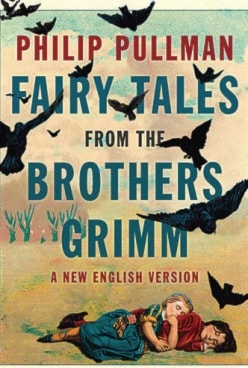Fairy Tales from the Brothers Grimm by Philip Pullman c.2012, Viking $27.95 / $29.50 Canada 406 pages
Happily ever after.
Once upon a time, those were magic words to you. They tied up a bedtime story neat enough to lull you to sleep. They put a nice, sweet bow on a story that let you know everything was all right in Make-Believe World.
Those three words, well, you’d love to share them with your own kids, especially since this is the bicentennial year for Grimm’s Fairy Tales. But as you’ll see in Fairy Tales from the Brothers Grimm by Philip Pullman, you might want to do some editing before you do.
Long ago, two “diligent and serious-minded” brothers, Jacob and Wilhelm Grimm, were on a path to become lawyers like their father. But when the elder Grimm died in 1796, the family had to depend on support from maternal relatives and the boys were sent to University. There, they decided to collect and publish fairy tales, which had become a “widespread preoccupation of the time.”
The first version of their collection was published in 1812, and by 1857 it was “immensely popular.” The collection had also grown bigger and, as does any good folk tale, it changed to reflect the times, piety and the culture of its readers.
“The fairy tale is in a perpetual state of…alteration,” says Pullman, who admits this book is not an authoritative text for reading aloud. Instead, he encourages readers to tell these stories with a personal, improvisational spin.
In this book, he’s done just that.
Pullman softens some of the classics, adding endings that make a tale make sense. In many, he traced the origins to learn where the story came from, how it was initially intended, what “morals” were implied, and oddities that were original. He points out any similarities between the tales as he discovered them, and other fairy tales, movies, plays, and stories.
But this book isn’t just another adaptation: there’s still a lot of the magic you’d find in any fairy tale book: talking frogs, tattling horses, beautiful princesses, benevolent kings, and riches from beggars. You’ll find recognizable stories that are tucked in the recesses of your kid-mind: The Princess and the Frog, Rumpelstiltskin, Hansel & Gretel, The Robber Bridegroom, and Cinderella.
But what most adults have forgotten (I sure had!) — and what author Philip Pullman found — was that the original fairy tales weren’t all Disney and light.
Fairy tales, as the Brothers Grimm knew them, included an awful lot of horrors: incest, murder, torture, beatings, parents killing children, animal cruelty, children killing parents, child abandonment, promiscuity, cannibalism and a lot of interacting with dead bodies.
Yikes.
Difficult to accept, yes. And yet, I liked this book for what it is: a morphing collection of fairy tales presented for the next storyteller to add to or subtract from. It’s creepy, it’s familiar, it’s dark, but it’s irresistible for adults only.
As for small kids, no, this is definitely not for them. Instead, find them something tamer because Fairy Tales from the Brothers Grimm will leave them unhappily for a good long time.
